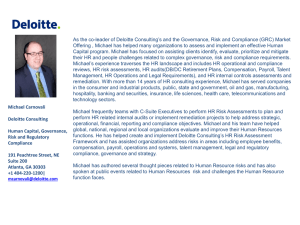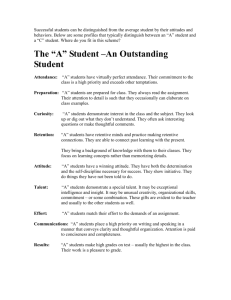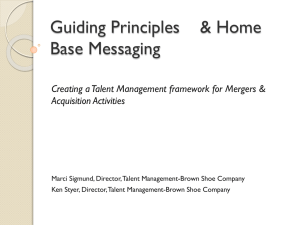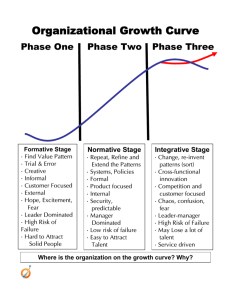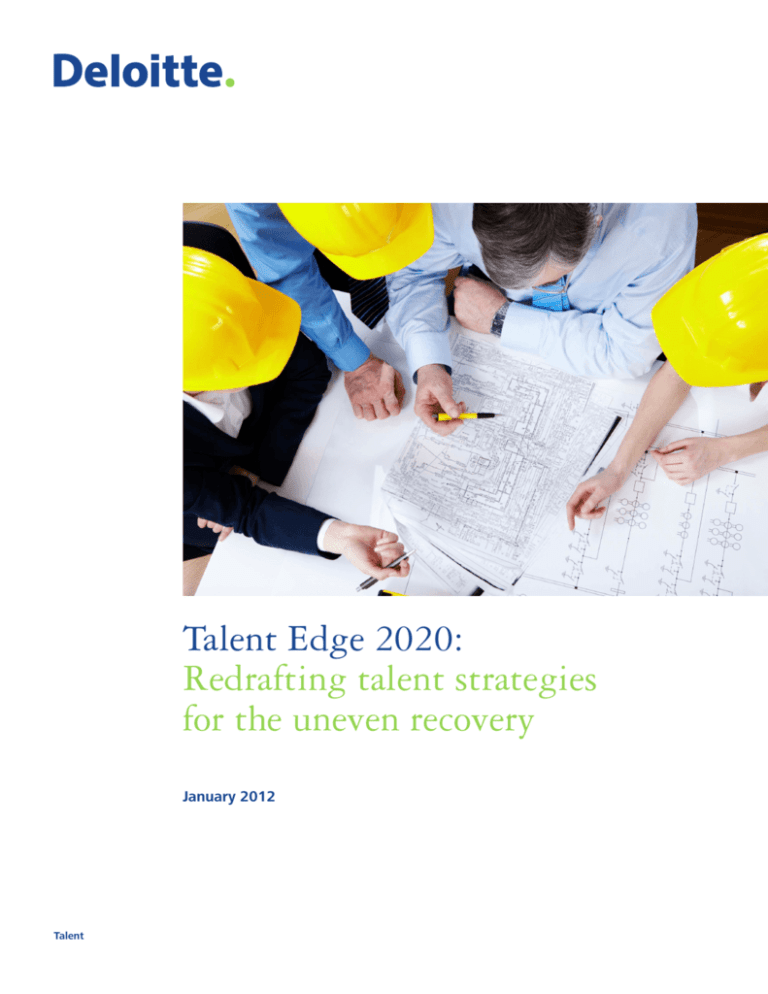
Talent Edge 2020:
Redrafting talent strategies
for the uneven recovery
January 2012
Talent
Contents
Contents
1 Key findings
3 Seeking new sources of growth in a stalled economy—and the talent to
exploit new opportunities
4 Strengthening leadership pipelines through innovative strategies
8 Global talent plans challenged by regional needs
10 Spotlight: Talent programs falling short, investment not up to the challenge
14 The bottom line
15 Survey demographics
17Contacts
Talent Edge 2020 is a longitudinal survey series conducted for Deloitte Consulting LLP
by Forbes Insights exploring changing talent priorities in all industries, at large businesses
worldwide in the Americas, Asia Pacific, and Europe, the Middle East, and Africa. The
Talent Edge 2020 series follows the Managing Talent in a Turbulent Economy series from
2009 and 2010.
Talent Edge 2020:
Building the recovery together—
What talent expects and how
leaders are responding
April 2011
Talent Edge 2020: Building the recovery together—
What talent expects and how leaders are responding
This report probes divergences between the attitudes and desires
of three generations of employees and the talent strategies and
practices being utilized by employers. This report features results
from a March 2011 survey that polled 356 employees at large
businesses around the world.
Talent
Read Talent Edge 2020: Building the recovery together—What
talent expects and how leaders are responding
Talent Edge 2020:
Blueprints for the new normal
Talent Edge 2020: Blueprints for the new normal
This inaugural report features results from an October 2010 survey
that polled 334 senior business leaders and human resource
executives at large global businesses. This report explores talent
strategies and unfolding employee trends related to retention and
the new challenges posed by the recession.
December 2010
Read Talent Edge 2020: Blueprints for the new normal
Talent
Key findings
As 2012 begins to unfold, we can see that the hopes for
a global economic recovery in 2010 gave way to a new
wave of economic doubts throughout 2011. Many business leaders are recognizing the critical need to develop
leaders to guide their organization in a new age of uncertainty. Many executives foresee leadership shortages in
the year ahead and are looking at programs to accelerate
leadership development within their companies. At the
same time, given the stalled economy, many companies
are seeking new sources of growth and are tailoring talent
plans to address differing regional needs to support effective talent strategies and business operations.
To help shed light on how companies are adjusting to
the demands of today’s uneven talent market, Deloitte
launched Talent Edge 2020—a longitudinal survey series
conducted in collaboration with Forbes Insights. This
January 2012 edition of Talent Edge 2020 builds from the
findings of two earlier studies: the first from a December
2010 report on executive attitudes and the second from
an April 2011 report on global employee attitudes and
talent concerns.
Survey respondents anticipate greater
executive leadership shortages over the
next several years than any other
talent category in their companies—
and also rank leadership as their most
pressing talent concern.
Our overall goals are to identify significant trends driving
corporate talent strategies and to track how companies
are responding to shifting economic realities. In October
2011, Forbes Insights surveyed 376 senior executives
and talent managers at large companies (annual sales of
+$500 million) worldwide, across a range of major industries. Among the key findings:
Many companies are seeking new sources of
growth in a stalled economy
As the economic recovery stalls and economists debate
the likelihood of a double dip recession, surveyed senior
executives worldwide focused on seeking out new markets for growth in order to bolster both top- and bottomline performance.
• When asked to rank their top strategic priorities,
38% of surveyed executives listed improving top- and
bottom-line performance, followed by expanding into
global and new markets at 33%.
Many executives are looking to strengthen their
leadership development pipelines and programs
Survey respondents anticipate greater executive leadership
shortages over the next several years than any other talent
category in their companies—and also rank leadership as
their most pressing talent concern. Companies are also exploring new accelerated leadership development programs
to overcome expected shortfalls in leadership positions.
• Approximately one-third (30%) of executives surveyed
ranked developing leaders and succession planning as
today’s top talent priority—the highest of any response
in the survey. A nearly equal percentage (29%) predicted it will likely remain the top talent concern over
the next three years.
As used in this document, “Deloitte” means Deloitte Consulting LLP, a subsidiary of Deloitte LLP. Please see www.deloitte.com/us/about for a detailed description of the legal structure
of Deloitte LLP and its subsidiaries. Certain services may not be available to attest clients under the rules and regulations of public accounting. The statements in this report reflect our
analysis of survey respondents and are not intended to reflect facts or opinions of any other entities. All survey data and statistics referenced and presented in this report, as well as the
representations made and opinions expressed, unless specifically described otherwise, pertain only to the participating organizations and their responses to the Deloitte survey conducted
October 2011.
Talent Edge 2020: Redrafting talent strategies for the uneven recovery
1
As talent demands go increasingly global, the
pressure is building to create talent strategies that
can both scale (for size and efficiency) and focus on
regional markets
A significant percentage of executives surveyed predict
talent shortages to develop over the next year, but the
areas of greatest need vary widely by region. This dual
emphasis of scale and focus is more important than ever
as companies seek to both exploit the global reach—and
cost efficiencies—of talent systems and processes while
focusing on the unique challenges within regional and
country markets.
• Surveyed Asia Pacific (APAC) executives face urgent
needs, with significant shortages anticipated in research
and development (R&D) (68%), operations (64%), and
strategy and planning (62%). Survey participants in the
Americas saw executive leadership and operations as
the main talent gaps (both 56%), while business leaders
in the Europe, the Middle East, and Africa (EMEA) region were far less concerned about shortfalls in talent.
2
Talent Edge 2020: Redrafting talent strategies for the uneven recovery
Many corporate talent programs are falling short
on performance and investment
Many business leaders at the companies surveyed see the
need for significant improvement in key areas across their
talent management programs. Those executives who rated
their talent programs as “world-class” also give higher
ratings than their peers to both their capabilities and their
levels of investment.
• Only 17% of executives surveyed believed their talent
programs were “world-class across the board,” while
83% acknowledged that significant improvements need
to be made. Executives who call their talent efforts
“world-class” were more likely to report—by margins
of 20 percentage points or more—that their companies
were investing in these programs at a “high” level.
A significant percentage
of executives surveyed
predicted talent shortages to develop over the
next year, but the areas of
greatest need vary widely
by region.
Seeking new sources of growth in
a stalled economy—and the talent
to exploit new opportunities
As world economies teeter between hesitant growth
and a return to recession, Deloitte’s analysis of the latest
survey data suggests that many top corporate executives
are increasingly looking for new avenues of growth, while
at the same time keeping an eye firmly fixed on bringing
costs into line with economic realities.
When asked to rank their top three strategic priorities,
38% of the executives surveyed listed improving top- and
bottom-line performance—the highest management
priority in the survey. Expanding into emerging and global
markets ranked second among management priorities
at 33%, while managing costs and acquiring/serving/
retaining customers tied for third at 32%, followed by
managing human capital at 30% (Figure 1).
Digging Deeper: Since Deloitte released its first longitudinal talent survey results in February 2009, the
percentages of surveyed executives who report that
their companies are focused on expanding into global
and new markets have been steadily rising. As mature
economies struggle with growth rates, the search for
overseas opportunities has accelerated significantly
(Figure 2).
Figure 2. Executives reporting that “expanding into
global and new markets” is a top strategic priority
33%
28%
Figure 1. Which top three strategic issues currently capture the most
management attention at your company?
38%
Improving top- and bottom-line performance
12%
Cutting and managing costs
32%
Acquiring/serving/retaining customers
32%
30%
Managing human capital
Developing new products and services
28%
Addressing risk and regulatory challenges
Investing in innovation/R&D
Leveraging technology
Capitalizing on M&A/divesture/
restructuring
14%
33%
Expanding into global and new markets
22%
Feb-09*
Jan-10**
Dec-10***
Jan 2012
* Managing talent in a turbulent economy: Playing both offense and defense,
February 2009, Deloitte Consulting LLP.
** Managing talent in a turbulent economy: Where are you on the recovery curve?
January 2010, Deloitte Consulting LLP.
*** Talent Edge 2020: Blueprints for the new normal, December 2010, Deloitte
Consulting LLP.
18%
17%
15%
Talent Edge 2020: Redrafting talent strategies for the uneven recovery
3
Strengthening leadership
pipelines through innovative
strategies
Given increasing levels of economic uncertainty, perhaps
it is not surprising that the current talent management
environment, as evidenced by responses to our survey,
appears complex and defies easy categorization.
Executives are focused on developing new leaders and
succession planning, with 30% of survey participants
listing it as one of their top three pressing talent
concerns—the highest talent concern in the survey. Also
vying for attention is recruiting employees with hard-tofind skills (Figure 3).
Figure 3. Organizations’ top three most pressing talent concerns in 2011
Developing leaders and succession planning
30%
Recruiting hard-to-find skill sets
29%
Sustaining employee engagement/morale
25%
Reducing employee headcount and costs
23%
Competing for talent globally and in
emerging markets
23%
Retaining employees at all levels
22%
Creating career paths and challenging job
opportunities
Aligning HR and talent with line
of business priorities
19%
Managing a globally diverse workforce
19%
Providing competitive compensation and
benefit packages
19%
Evaluating and implementing HR/
talent technology systems
16%
Deploying critical talent around the world
16%
Managing and delivering training programs
Providing flexible work options
4
20%
Talent Edge 2020: Redrafting talent strategies for the uneven recovery
13%
11%
As expanding into new and global markets has jumped
up the management priority list, talent managers are
rising to the challenge. Competing for talent globally and
in emerging markets was named a top talent concern by
nearly one in four (23%) executives surveyed. When asked
to look forward three years from now, the global talent
search rises even higher on the agenda to 27%.
In their efforts to identify and develop new leaders, create
effective succession plans, and build global workforces,
executives are aligning their talent management practices
to meet these goals. In our survey, more than seven
out of 10 executives surveyed singled out performance
management, talent assessment, and high-potential
employee development as core talent priorities that are
anticipated to increase over the next 12 months (Figure 4).
Figure 4. Organizations’ increasing focus on core talent management priorities
over the next 12 months
73%
Performance management
Talent assessment (focusing on potential)
72%
High-potential employee deployment
71%
Experienced hires
63%
62%
Job-specific/functional training
58%
Regulatory, security and risk training
Onboarding and orientation
56%
Right-sizing/down-sizing
55%
Offshore hires
Campus hires
Contract and part time
This theme—an emphasis on developing the next
generation of corporate leaders—appeared again when
executives were asked to anticipate how their emerging
talent management strategies were likely to change during
the next 12 months. According to the executives who
participated in the survey, over the course of the next year,
many companies intend to focus on accelerated leadership
development, with 40% of survey respondents ranking
it in the top three. This focus makes sense as the goal of
accelerated leadership development is to create a deep
pipeline of potential leaders with capabilities that match
each organization’s particular business needs. It also
creates a strong talent brand that inspires employees and
helps attract high-potential candidates from the outside.
Despite a persistently weak job market and high levels of
unemployed workers seeking jobs, many executives are
worried about the possible departure of potential leaders.
Of the executives who participated in the survey, 71%
expressed a “high” or “very high” concern about retaining
critical talent over the next 12 months, along with 66%
who had the same concern about keeping high-potential
talent.
49%
47%
42%
71% of survey respondents expressed
a “high” or “very high” concern about
retaining critical talent over the next
12 months, along with 66% who
had the same concern about keeping
high-potential talent.
Talent Edge 2020: Redrafting talent strategies for the uneven recovery
5
Five Takeaways on Leadership
Leadership represented a recurring theme throughout Deloitte’s January 2012 edition
of Talent Edge 2020. As surveyed executives analyzed their existing talent plans to
chart future strategies, their top concerns include the following five points:
• Developing Leaders and Succession Planning: Surveyed executives ranked
developing leaders/succession planning as the top talent concern both today and
three years from now.
• Struggling to Keep Leadership Teams Intact: A majority of executives
surveyed expressed concern about their organizations’ ability to retain company
leaders.
• Predicting Leadership Shortages: Across all talent areas, executives predicted
the most severe shortages will likely occur in leadership, particularly in the
Americas and EMEA.
• Focusing on Leadership Pipeline: Accelerated leadership development was
rated the number one emerging talent strategy among global executives who
participated in the survey.
• Closing the Gap Between Priority and Performance: Most executives
surveyed rated leadership development a high priority at their companies—yet far
fewer rated their leadership development capabilities highly.
Since companies can easily match
compensation packages, Deloitte
believes companies can differentiate
themselves in the talent marketplace by
going beyond financial incentives and
creating customized retention strategies
that address issues such as career
advancement and greater recognition.
6
Talent Edge 2020: Redrafting talent strategies for the uneven recovery
Generationally, executives and talent managers appear
most concerned about retaining the future leaders of
their companies. Nearly half of the respondents
(47%) report a “high” or “very high” concern about
Millennial employees departing for other firms, compared
to 42% for Generation X employees and just 32% for
Baby Boomers.
Data from Deloitte’s April 2011 Talent Edge 2020
employee report makes it clear that employers are right
to be concerned since 65% of surveyed employees
were already looking for a new job or planning to look
for a new job—but they may not have a good handle
on which employees they risk losing. The employers
who participated in the January 2012 report were most
concerned about losing employees from Generation Y.
However, according to our April 2011 employee report,
72% of Generation X employees are already looking or
plan to make their next career move, compared to 63% of
Millennials.
Are companies taking the steps necessary to retain top
employees? The evidence is mixed. Four in ten (40%)
executives surveyed confirmed that their organization has
an updated retention plan in place, and another 36%
reported that an updated retention plan is in the works.
However, only 30% of executives surveyed were “very
confident” in the overall effectiveness of their company’s
retention strategies and programs.
Our April 2011 employee report suggested that different
generations have different goals, expectations, and
desires—and organizations should tailor and target their
talent strategies to satisfy each employee group from Baby
Boomers to Gen Xers to Millennials. Surveyed executives
appear to understand that different retention initiatives
appeal to different generations. The only incentive
ranked among the top three by surveyed executives for
all generational groups was additional bonuses/financial
incentives (Figure 5). Since companies can easily match
compensation packages, Deloitte believes companies
can differentiate themselves in the talent marketplace by
going beyond financial incentives and creating customized
retention strategies that address issues such as career
advancement and greater recognition. In addition,
organizations should focus on creating connections as
employees are more likely to stay in an organization
where they feel connected—to other employees, to
their manager to the organization’s purpose, and to the
resources they need.
from supervisors as a key retention incentive—the only
generational group to list this issue within their top
three.
• Money Matters: Every generation of employees
surveyed ranked additional compensation among the
top three incentives for keeping them with their current
employers. However, employers did not list additional
compensation near the top for any generation—
although they did see the value in additional bonuses
or other financial incentives.
Designing effective retention strategies starts with a clear
understanding of employee goals and desires. However,
there appears to be a disconnect between employers and
employees in three areas:
• Intensity Gap: Employers recognized that promotion/
job advancement is a strong retention tool, but they
appear to be underestimating just how powerfully this
incentive impacts all generations of employees. When it
comes to Generation X, both employers and employees
ranked promotion/job advancement at the top, but
employees rate it 32 percentage points higher than
their employers. For Generation Y, the intensity gap is
eight percentage points (Figure 5).
• Employer-Boomer Mismatch: Employers believe
Baby Boomers are interested in additional benefits,
additional bonuses, and flexible work arrangements.
However, this generation is seeking more than just
additional compensation and flexible schedules.
According to our April 2011 report, Baby Boomers
ranked promotions/job advancement as their top
retention incentive at 50%; however, this incentive did
not even appear among the top three in the employer
survey. More than four in ten (43%) Baby Boomers
surveyed also ranked increased support/recognition
These findings suggest that executives may be
exacerbating company pipeline issues by not focusing on
the initiatives which can more effectively retain employees.
Employers recognize that
promotion/job advancement is a strong retention
tool, but they appear to be
underestimating just how
powerfully this incentive
impacts all generations of
employees.
Figure 5. Top three most effective retention initiatives by generation: Executives vs. employees
Gen Y/Millennials (31 and younger)
Ranking
Executives
Employees*
Generation X (ages 32-47)
Executives
Employees*
Baby Boomers (ages 48-65)
Executives
Employees*
1
Promotion/job
advancement
(33%)
Promotion/job
advancement
(41%)
Promotion/job
advancement
(32%)
Promotion/job
advancement
(64%)
Additional benefits
(e.g., health and
pensions) (42%)
Promotion/job
advancement
(50%)
2
Individualized
career planning
(within your
company) (27%)
Additional
compensation
(40%)
Additional bonuses
or financial incentives (31%)
Additional bonuses
or financial
incentives (41%)
Additional bonuses
or financial
incentives (33%)
Support and
recognition from
supervisors or
managers (43%)
3
Additional
bonuses or
financial
incentives (25%)
Additional bonuses
or financial
incentives (33%)
Leadership
development
programs and
flexible work
arrangements
(tie at 29%)
Additional
compensation
(33%)
Flexible work
arrangements
(32%)
Additional
compensation
(42%)
* Talent Edge 2010: Building the recovery together—What talent expects and how leaders are responding, April 2011, Deloitte Consulting LLP.
Talent Edge 2020: Redrafting talent strategies for the uneven recovery
7
Global talent plans
challenged by regional needs
As many companies look overseas for growth, the
competition for talent is increasingly global—a trend we
first identified in the December 2010 edition of Talent
Edge 2020. Analyzing the results of this new survey, it
quickly became apparent that companies should adapt
their talent strategies and priorities to fit different global
regions while also addressing the simultaneous challenge
of scale. When surveyed executives were asked to forecast
areas where they expect talent to be in short supply over
the next year, where they were located had a significant
influence on the talent they believe they will need, with
APAC having greater shortages than both EMEA and the
Americas (Figure 6).
Digging Deeper: The talent required in the coming years will vary significantly by
industry. These differences are especially pronounced in Energy/Utilities and Financial
Services. For example, only 7% of respondents in the Financial Services industry believe
they will have severe talent shortages in operations, while 37% of respondents in
Energy/Utilities expect these shortages. Over two in three (67%) respondents in
Financial Services expect slight to no shortages in marketing, compared to 57% in
Energy/Utilities who expect moderate to severe marketing talent shortages.
Figure 6. Do you expect significant or moderate talent
shortages in the following areas over the next year?
8
Functional Area
APAC
Americas
EMEA
R&D
68%
45%
33%
Operations
64%
56%
34%
Procurement and supply chain
64%
36%
19%
Risk and regulatory
63%
41%
38%
Strategy and planning
62%
46%
38%
Customer service
62%
38%
22%
Sales
60%
44%
28%
IT
59%
50%
33%
Executive leadership
58%
56%
47%
HR and talent
56%
44%
32%
Marketing
56%
43%
24%
Finance
56%
38%
24%
Average across 12
functional areas
61%
45%
31%
Talent Edge 2020: Redrafting talent strategies for the uneven recovery
In the APAC region, more than half of executives surveyed
predict talent shortages across all twelve of the functional
areas surveyed, with an overall average of 61%. The
most pressing needs appear to be in R&D, where 68%
of APAC executives foresee talent shortages, followed by
operations and procurement and supply chain at 64%,
and then strategy and planning at 62% (Figure 6).
The shortages that APAC executives surveyed are
predicting are in line with results reported from our April
2011 employee report. When asked if workers were
already looking or planning to search for a new job in the
next 12 months, a majority of surveyed APAC employees
said “yes” at 59%.
Executives in the EMEA region appear to face far less
pressing talent shortages than in APAC or the Americas,
with an average across the 12 functional areas of only
31% (30 percentage points less than APAC). Nearly half
(47%) of those surveyed in EMEA see potential shortages
in executive leadership talent, but that was the only
category that rose above 40% (Figure 6). In the Americas,
surveyed executives anticipate significant talent shortages
in executive leadership (56%), operations (56%), and IT
(50%) (Figure 6).
Digging Deeper: Is R&D falling off the executive radar screen? In Deloitte’s December
2010 survey report, nearly three-quarters of executives (72%) forecasted talent shortages in R&D. Those concerns seem to have eased—only 47% now say R&D will need a
talent infusion in the next 12 months (Figure 7). This same trend was evident when we
asked executives what strategic issues were at the top of their agendas. In 2010, 27%
ranked R&D highly, compared to just 18% who did so in 2011 (Figure 1). While R&D is
typically a long-term play and the payoffs often do not come for years, many companies are being pressured to focus on short-term cost containment as well as revenue
generation given the uncertain economy. So if a company is looking to bolster its balance sheet, they may be sacrificing long-term R&D for short-term benefits.
Figure 7. Talent shortages comparison 2011 vs. 2010
53%
57%
Executive leadership
Operations
51%
49%
Strategy and planning
47%
51%
72%
Risk and regulatory
46%
49%
IT
46%
49%
50%
43%
Sales
52%
Customer service
40%
Marketing
40%
Finance
2011
2010*
43%
HR and talent
Procurement and supply chain
Regional differences were also reflected in projected hiring
patterns over the next year, with APAC again showing
a far more vigorous talent market and more aggressive
hiring plans.
47%
R&D
Over the course of the
next 12 months, about
three out of four executives surveyed in the
APAC region expect to
ramp up hiring across the
board in virtually every
organizational function.
Over the course of the next 12 months, about three out
of four executives surveyed in the APAC region expect
to ramp up hiring across the board in virtually every
organizational function. The hottest talent areas in the
APAC region are anticipated to be operations, sales,
and marketing. In each of these areas, more than 80%
of executives and talent managers expect to be hiring
additional employees during the next year.
46%
46%
38%
48%
38%
* Talent Edge 2020: Blueprints for the new normal; December 2010, Deloitte Consulting LLP.
48%
In the Americas, 72% of executives surveyed anticipate
hiring additional employees in operations, along with
63% in IT and 62% each in sales and R&D. The hiring
picture looks far bleaker in the EMEA region. The only
categories for which more than four in ten executives
surveyed planned additional hiring were sales at 45% and
operations at 44%, according to the October 2011 data.
Talent Edge 2020: Redrafting talent strategies for the uneven recovery
9
Spotlight: Talent programs
falling short, investment
not up to the challenge
In each edition of Talent Edge 2020, Deloitte shines
the spotlight on one key area of talent management in
order to gain a more in-depth understanding of where
companies are excelling and why. In our October 2011
survey, we asked executives to assess their capabilities
across seven critical talent management initiatives and to
rate both the level of importance and investment in each.
As Deloitte began to dig deeper with questions about
specific talent programs, three conclusions stood out:
• Most executives surveyed rated talent management
programs a high priority;
• Many did not have a high degree of confidence in their
capabilities to deliver the talent, skills, and leaders they
need; and
• Companies with self-assessed “world-class” talent
programs see both their capabilities and investment
commitments differently than their counterparts at
other organizations.
While most executives agree talent
management programs are a high
priority, many lack confidence in their
capabilities to deliver the talent, skills,
and leaders they need.
10 Talent Edge 2020: Redrafting talent strategies for the uneven recovery
Many companies recognize the need to assemble, train,
and retain a world-class workforce as they strive to
prosper in an increasingly competitive global economy.
Yet many executives appear to believe their talent
management programs are not up to the challenge. Only
17% of executives surveyed believe their overall talent
management programs are “world-class”. More than four
in ten (43%) described their talent management programs
as adequate but in need of improvement, just getting by,
or underperforming (Figure 8).
Figure 8. Self-assessment of overall talent
management programs We are underperforming
and need radical
improvements
We are getting by
We are
3%
but need significant
world-class
improvements
17%
10%
We are adequate
but need to
improve
30%
We are world
class in
some areas
40%
Talent Management Priorities
Breaking the numbers down individually by priority,
capability, and investment level sharpens the picture.
Corporate emphasis on leadership development programs
was a recurring theme throughout this survey, so perhaps
it is not surprising that 53% of survey participants rated it
a “high” priority at their companies—the top choice out
of the seven talent management initiatives (Figure 9).
Interestingly, surveyed executives who called their
organizations’ talent management programs “world-class”
had a vastly different sense of which programs were more
important at their companies. While 56% agreed that
leadership development is important, executives at these
“world-class” companies ranked every other priority higher
(Figure 10). In Deloitte’s view, these findings suggest
that “world-class” companies have already focused on
developing their leadership pipelines and are turning their
attention to new priorities, such as workforce analytics
and talent function operating model.
Figure 9. Percent of respondents rating talent priority, capability, and level of investment as “high”
53%
Leadership development
33%
32%
42%
Talent functional operating model
28%
28%
41%
Priority
29%
28%
Global workforce management
Capability
40%
Investment
25%
25%
Determining return on investment (ROI)
40%
35%
Workforce analytics
26%
39%
Global rewards
33%
28%
36%
24%
26%
Talent operations, processes, and technologies
Figure 10. Importance of priority area is “high”: World-class talent programs vs. non-world-class talent programs
69%
68%
66%
36%
34%
66%
35%
61%
36%
58%
34%
56%
52%
32%
World-class talent
programs
Non-world-class talent
programs
Workforce
analytics
Talent functional
operating model
Determining
ROI
Global
workforce
management
Global
rewards
Talent operations, Leadership
processes, and development
technologies
Talent Edge 2020: Redrafting talent strategies for the uneven recovery
11
Digging Deeper: Depending on whether their company has experienced layoffs
in the past six months, there are some notable differences in the ways executives
think about their organizations’ talent areas. For surveyed executives who have seen
recent layoffs, almost half (48%) rated their talent function operating model as a high
priority. For those who have not experienced layoffs, this drops to just over one third
(37%). Also, at organizations that reported layoffs, almost half (47%) of executives
rated workforce analytics as a high priority—just one in three (33%) rated workforce
analytics as highly in organizations that have not experienced layoffs.
Of the executives who regarded their
talent programs as “world class,” 53%
rated their leadership development capabilities highly, compared to just 28%
of other respondents—a 25-point gap.
Figure 11. Capability in priority area is “high”: World-class talent programs
vs. non-world-class talent programs
World-class talent
programs
Non-world-class talent
programs
66%
58%
55%
55%
53%
44%
28%
28%
22%
Workforce
analytics
Global
rewards
Talent
functional
operating
model
24%
42%
28%
20%
Global
workforce
management
12 Talent Edge 2020: Redrafting talent strategies for the uneven recovery
Leadership
development
Talent
operations,
processes, and
technologies
21%
Determining
ROI
Talent Management Capabilities
Do talent management priorities align with corporate
capabilities? Not according to our survey data. When it
comes to leadership development, for example, 53% of
executives surveyed rated leadership programs a “high”
priority, yet only 33% believe they have “high” capabilities
in this area (Figure 9). We believe that organizations
looking to “raise their talent management game” in order
to better attract and retain employees may want to start
with improving their leadership development programs.
Perhaps not surprisingly, many companies with selfidentified “world-class” talent programs had significantly
more confidence in their capabilities across all seven
talent areas. Of the executives who regarded their talent
programs as “world class,” 53% rated their leadership
development capabilities highly, compared to just 28% of
other respondents—a 25-point gap (Figure 11).
Talent Management Investment
In addition to inquiring about talent priorities and
capabilities, Deloitte asked executives to rate the level of
investment their companies are making. In each instance,
the gap between talent program priorities and investment
was at least 10 percentage points, with the biggest gap
appearing in leadership development (Figure 9).
Comparing those companies with “world-class” talent
programs against their competitors proved to be
an interesting benchmarking exercise. By significant
margins—often 20 percentage points or more—surveyed
executives who rated their talent programs as “worldclass” also reported a “high” level of investment in these
initiatives (Figure 12).
Figure 12. Investment in priority area is “high”: World-class talent programs
vs. non-world-class talent programs
World-class talent
programs
55%
53%
Non-world-class talent
programs
52%
48%
48%
47%
37%
20%
19%
23%
Talent
Determining
Global
operations,
ROI
workforce
processes, and
management
technologies
24%
Global
rewards
29%
Leadership
development
24%
24%
Talent
functional
operating
model
Workforce
analytics
Leadership Checklist
Based on Deloitte research on leadership,* some of
the key steps organizations can take into consideration
when planning and implementing leadership development programs include:
• Aligning leadership strategy to business strategy
in order to measure individual and organization
success consistently.
• Creating a clear leadership capability framework so
the organization has a defined picture of what a
future senior leader needs to do well.
• Recognizing that leadership potential is different
than current performance—and learning how to
spot and assess for potential using objective criteria.
• Putting decision rights and governance in place
regarding developmental job moves for highpotentials.
• Creating high-impact programs to accelerate
on-the-job development and the formation of
critical support networks.
• Ensuring senior leaders are setting the right
example, including being “hands-on” in leadership
development programs.
* Source: Deloitte’s Leadership by design: An architecture to build leadership
in organizations, Deloitte Consulting, 2011.
Talent Edge 2020: Redrafting talent strategies for the uneven recovery
13
The bottom line
What a difference a year makes…
2011 started with the prospect of an imminent global
recovery and ended with the specter of a double dip
recession that threatened to create a long and uneven
global recovery. The standout findings from the latest
edition of Deloitte’s Talent Edge 2020 series are twofold:
the near universal agreement about the existing and
potentially growing shortage of executive leadership and
the significant regional differences in talent needs around
the globe. The world may now be one economy, but it is
definitely not one talent market.
According to the majority of executives surveyed for
this report, current corporate leadership development
programs are not capable of meeting the challenge ahead.
Surveyed executives report that their companies are not
investing the resources necessary to develop new leaders.
Looking to the future, in order to thrive, not just survive,
we believe executives should ask themselves three critical
questions:
• Where can we find opportunities for growth in an
uncertain economy that is recovering at different rates
in different regions?
• Do we have the right talent in the right places to
leverage those opportunities?
• Do we have the talent and leaders—and the
required talent programs—to weather the economic,
technological, and regulatory challenges ahead?
The world may now be one economy,
but it is definitely not one talent
market.
14 Talent Edge 2020: Redrafting talent strategies for the uneven recovery
Ultimately, building world-class talent programs requires
investment. Our research has shown that while fewer
than one in five surveyed executives self-identified their
organizations as “world-class” in talent, more than four in
five acknowledge the need for significant improvements
and investments. The organizations that self-report that
they are “world-class” in talent are not sitting back and
waiting for a slow recovery to solve their talent challenges.
These executives are more likely to invest (by a two to one
margin) across the board on talent priorities and initiatives.
These talent leaders are taking responsibility for their
futures and focusing investments and capabilities on their
top priorities. They are getting down to the brass tacks
(i.e., hard work) of rebuilding and developing new talent
programs for leaders and critical employees. In short,
self-assessed “world-class” companies are putting their
money on the table and investing in talent priorities and
programs.
Survey demographics
In the latest report of Deloitte’s Talent Edge 2020
longitudinal study, Forbes Insights surveyed 376 senior
executives, 66% of whom held Board, CEO, CFO,CHRO, or
HR/Talent Director positions (Figure 13).
As Figure 14 shows, all survey respondents were employed
by companies with annual revenues of more than $500
million. More than eight in ten (82%) work for companies
larger than $1 billion in revenues and 34% report their
companies generate revenues higher than $10 billion.
Figure 13. Which of the following describes your title?
Board Member
2%
CEO/President/Managing Director
CFO/Treasurer/Controller
5%
2%
CIO/Technology Director
CHRO/Chief Talent Officer
10%
2%
HR/Talent Director or Manager
SVP/VP/Director
Head of Business Unit
Head of Department
43%
6%
4%
7%
12%
Manager
Other
7%
Figure 14. Company revenues during the most recent fiscal year
30%
18%
18%
$500 million –
$1 billion
$1 billion –
$5 billion
$5 billion –
$10 billion
17%
17%
$10 billion –
$20 billion
Greater than
$20 billion
Talent Edge 2020: Redrafting talent strategies for the uneven recovery
15
As shown in Figure 15, participating executives are
dispersed through the world’s three major economic
regions: 38% in the Americas; 34% in Europe/Middle East/
Africa; and 28% in the Asia Pacific region.
Survey participants represent a broad set of
industries (Figure 16), including Technology/Media/
Telecommunications (27%), Consumer/Industrial
Products (27%), Energy/Utilities (19%), Life Sciences/
Health Care (9%), and Financial Services (15%).
Americas
38%
Life Sciences/
Health Care
9%
Asia Pacific
28%
Other
4%
Consumer/Industrial
Products
27%
Financial
Services
15%
Energy/
Utilities
19%
Figure 15. Respondents by location
Europe/Middle East/
Africa
34%
Figure 16. Company industries
Technology/Media/
Telecommunications
27%
Deloitte’s Talent Edge 2020 longitudinal study will
continue to track the shifts in talent strategies,
trends and priorities in the months ahead. The
next edition of the study will be published in the
spring of 2012 and will focus on employees.
16 Talent Edge 2020: Redrafting talent strategies for the uneven recovery
Contacts
Global Human Capital
Margot Thom
Global Human Capital Leader
Deloitte Consulting LLP
Canada
+1 416 874 3198
mathom@deloitte.ca
Gabi Savini
Global Market Offering Co-leader
Talent, Performance & Rewards
Deloitte Consulting LLP
South Africa
+2711 517 4274
gsavini@deloitte.co.za
Jeff Schwartz
Global Market Offering Co-leader
Talent, Performance & Rewards
Deloitte Consulting LLP
United States
+1 703 251 1501
jeffschwartz@deloitte.com
Human Capital – Americas
Jaime Valenzuela
Regional Leader, Americas
Human Capital
Deloitte Consulting LLP
Chile
+56 2 7298150
jvalenzuela@deloitte.com
Barbara Adachi
Human Capital Leader, United
States
Deloitte Consulting LLP
United States
+1 415 783 4229
badachi@deloitte.com
Alice Kwan
US Talent Services Leader
Deloitte Consulting LLP
United States
+1 212 618 4504
akwan@deloitte.com
Heather Stockton
Human Capital Leader, Canada
Deloitte & Touche
Canada
+1 416 601 6483
hstockton@deloitte.ca
Karen Pastakia
Talent Leader, Canada
Deloitte & Touche
Canada
+1 416 601 5286
kapastakia@deloitte.ca
Jorge Castilla
Human Capital Leader, Mexico
Deloitte México
Mexico
+52 55 50806110
jocastilla@deloittemx.com
Jorge Ponga
Talent Leader, Mexico
Deloitte México
Mexico
+52 55 50806418
jponga@deloittemx.com
Andrew Heng Wan Lee
Human Capital Leader, Malaysia
Deloitte Consulting LLP
Malaysia
+60 3 7723 6576
andrewlee@deloitte.com
Henri Vahdat
Human Capital Leader, Brazil
Deloitte Consulting LLP
Brazil
+55 11 51861747
hvahdat@deloitte.com
P. Thiruvengadam
Human Capital Leader, India
Deloitte Touche Tohmatsu India
Pvt. Ltd.
India
+91 80 6627 6108
pthiruvengadam@deloitte.com
Luiz Barosa Oliveira
Talent Lead, Brazil
Deloitte & Touche
Brazil
+55 11 51861059
luizoliveira@deloitte.com
Human Capital – Asia Pacific
Richard Kleinert
Regional Leader, Asia Pacific
Human Capital
Deloitte Consulting LLP
New Zealand
+64 21 680999
rakleinert@deloitte.co.nz
Hugo Walkinshaw
Human Capital Leader, South
East Asia
Deloitte Consulting SEA
Singapore
+65 6232 7112
hwalkinshaw@deloitte.com
Mario Ferraro
Talent Leader, South East Asia
Deloitte Consulting SEA
Singapore
+65 6535 0220
maferraro@deloitte.com
Lisa Barry
Human Capital Leader, Australia
Deloitte Consulting LLP
Australia
+61 3 9671 7248
lisabarry@deloitte.com.au
Jason White
Talent Leader, Australia
Deloitte Consulting LLP
Australia
+61 2 9322 7759
jaswhite@deloitte.com.au
Kenji Hamada
Human Capital Leader, Japan
Deloitte Tohmatsu Consulting
Co., Ltd.
Japan
+81 80 4358 7073
kehamada@tohmatsu.co.jp
Seok Hoon Yang
Human Capital Leader, Korea
Deloitte Consulting LLP
Korea
+82 2 6676 3800
seoyang@deloitte.com
Jungle Wong
Human Capital Leader, China
Deloitte Touche Tohmatsu CPA
Ltd
China
+ 86 10 8520 7807
junglewong@deloitte.com.cn
Human Capital – Europe,
Middle East, & Africa
Brett Walsh
Regional Leader, EMEA
Human Capital
Deloitte Consulting LLP
United Kingdom
+44 20 7007 2985
bcwalsh@deloitte.co.uk
Dr. Udo Bohdal
Human Capital Leader, Germany
Deloitte Consulting GmbH
Germany
+49 69 97137350
ubohdal@deloitte.de
Trevor Page
Human Capital Leader,
South Africa
Deloitte Consulting
South Africa
+2711 517 4263
trepage@deloitte.co.za
Yves Van Durme
Human Capital Leader, Belgium
Deloitte Consulting LLP
Belgium
+32 2 749 59 97
yvandurme@deloitte.com
Sue Conder
Talent Leader, United Kingdom
Deloitte Consulting LLP
United Kingdom
+44 20 7007 2991
sueconder@deloitte.co.uk
Ghassan Turqieh
Human Capital Leader, Middle
East
Deloitte Consulting LLP
Lebanon
+ 961 1 366844
gturqieh@deloitte.com
Ardie Van Berkel
Human Capital Leader,
Netherlands
Deloitte Consulting LLP
Netherlands
+31 88 2881834
AvanBerkel@deloitte.nl
Kees Flink
Talent Leader, Netherlands
Deloitte Consulting LLP
Netherlands
+31 88 2884984
kflink@deloitte.nl
David Yana
Human Capital Leader, France
Deloitte Consulting LLP
France
+33 1 58 37 96 04
dyana@deloitte.fr
Christian Havranek
Human Capital Leader, Austria
Deloitte Consulting LLP
Austria
+43 15 37002600
chavranek@deloitte.at
Katja Teuchmann
Talent Leader, Austria
Deloitte Consulting LLP
Austria
+43 15 37002610
kteuchmann@deloitte.at
Gilbert Renel
Human Capital Leader,
Luxembourg
Deloitte Consulting LLP
Luxembourg
+352 45145 2544
grenel@deloitte.lu
Sarah Kane
Human Capital Leader,
Switzerland
Deloitte Consulting LLP
Switzerland
+41 44 421 6873
sakane@deloitte.ch
Andre Schwaninger
Talent Leader, Switzerland
Deloitte Consulting LLP
Switzerland
+41 44 421 6895
aschwaninger@deloitte.ch
Elena Chernova
Human Capital Leader, Russia
Deloitte Consulting LLP
Russia
+74957870600 Ext.1061
echernova@deloitte.ru
Talent Edge 2020: Redrafting talent strategies for the uneven recovery
17
Item #100335
About the survey
Talent Edge 2020 is a follow up to the Managing Talent in a Turbulent Economy
longitudinal talent survey series. This survey explores the changing talent priorities and
strategies of executives at global and large national companies. This report features
results from an October 2011 survey that polled 376 senior business leaders and human
resource executives at large businesses in the Americas, Asia Pacific, and Europe, the
Middle East, and Africa. For more information see www.Deloitte.com/us/talent.
The statements in this report reflect our analysis of survey respondents and are not intended to reflect facts or opinions of any other
entities. All survey data and statistics referenced and presented, as well as the representations made and opinions expressed, unless
specifically described otherwise, pertain only to the participating organizations and their responses to the Deloitte survey.
This publication contains general information only and is based on the experiences and research of Deloitte practitioners. Deloitte is not,
by means of this publication, rendering business, financial, investment, or other professional advice or services. This publication is not a
substitute for such professional advice or services, nor should it be used as a basis for any decision or action that may affect your business. Before making any decision or taking any action that may affect your business, you should consult a qualified professional advisor.
Deloitte, its affiliates, and related entities shall not be responsible for any loss sustained by any person who relies on this publication.
Copyright © 2011 Deloitte Development LLC. All rights reserved.
Member of Deloitte Touche Tohmatsu Limited



